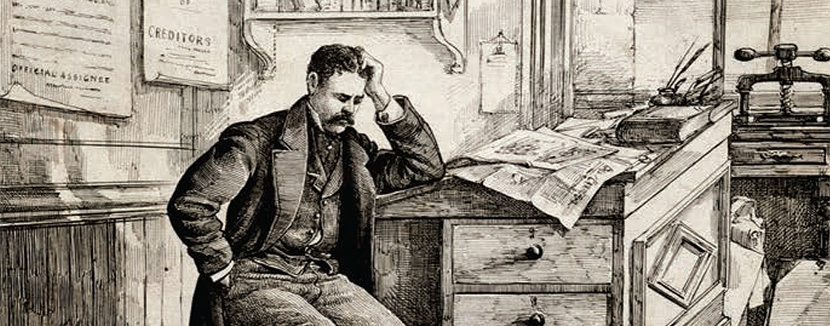Rebuilding Success Magazine Features - Fall/Winter 2022 > One Hundred Years of Bankruptcy and Insolvency Law in Canada
One Hundred Years of Bankruptcy and Insolvency Law in Canada
 |
July 1, 2020 marked the centenary of Canada’s foundational bankruptcy statute. Parliament passed the Bankruptcy Act in 1919 and it came into force the following year. The 100th anniversary of this statute gives reason to pause to consider its origins and importance. As Jacob Ziegel writes, the Bankruptcy Act “still provides the conceptual framework for the current Bankruptcy and Insolvency Act.”[1] What makes this statute even more remarkable is that it was Canada’s first bankruptcy statute after a near forty-year hiatus. Between 1880 and 1920, there was no federal bankruptcy legislation in Canada. This article explains the origins of the Bankruptcy Act and considers its immediate aftermath.
Bankruptcy law has long been accepted as a necessary feature of modern commercial law. However, in nineteenth and early twentieth century Canada, the dominant question was whether there should be a bankruptcy law at all. The two central goals of bankruptcy law -- providing individuals with a discharge from their debts, and the equitable distribution of a bankrupt’s assets among its creditors -- proved to be controversial. Bankruptcy law-making in the nineteenth century was tentative at best. Parliament first exercised its constitutional jurisdiction over “bankruptcy and insolvency” by enacting the Insolvent Act of 1869 and then the more pro-creditor Insolvent Act of 1875. The 1875 Act abolished voluntary bankruptcy proceedings. Both statutes enabled debtors to obtain a discharge, but the discharge was available only upon required levels of creditor consent. The scope of nineteenth century bankruptcy law was very narrow, as its application was limited to traders. The controversial nature of nineteenth century bankruptcy legislation was evident in that between 1869 and 1880, Parliament debated 10 repeal bills. To many, the discharge was an evil as it interfered with a debtor’s higher obligation to repay debts. The movement to end the bankruptcy discharge finally succeeded in 1880 when Parliament repealed the Insolvent Act of 1875, leaving the country with no bankruptcy legislation at all.
Parliament considered reinstating a bankruptcy regime twenty times between 1880 and 1903, but all reform bills failed. Parliament did not discuss bankruptcy reform again until 1918. Although Prime Minister Wilfrid Laurier was content to allow the provinces to regulate debtor-creditor matters, the growth of interprovincial trade and the move away from a local economy generated renewed interest in a uniform federal bankruptcy regime. During the War, the Canadian Bar Association and the Canadian Credit Men’s Trust Association (CCMTA) began to press for a national bankruptcy statute. The CCMTA represented authorized assignees who administered estates under provincial assignments legislation. The CCMTA identified four defects in provincial debtor-creditor law:
- Provincial law was non-uniform.
- There was an absence of machinery which compelled an insolvent debtor to turn over the debtor’s property to a trustee for an equitable distribution to creditors.
- There was no national composition scheme.
- Provincial law did not grant an unfortunate but honest debtor the right of a discharge.
Parliament first debated the Bankruptcy Bill in 1918 and passed the legislation the following year. But the Bill did not come from the pen of a civil servant or from the halls of the Department of Justice. The CCMTA retained Winnipeg lawyer H.P. Grundy to draft a bankruptcy bill that would protect their interests. Using the UK Bankruptcy Act of 1914 as a model, Grundy sought to safeguard Canadian commercial interests by drafting a bill providing for uniformity, an involuntary bankruptcy procedure (based upon proof of acts of bankruptcy), a composition scheme, and a discharge. Grundy submitted his Bill to the Minister of Justice on June 21, 1917. Grundy and the CCMTA then lobbied the government and Members of Parliament to ensure that the Bill would pass.
Under the new legislation, courts supervised the administration of the new bankruptcy discharge. The idea of giving judges the power to refuse, suspend or impose conditions on a discharge dates back to the original Bankruptcy Act. The inclusion of the discharge in the Bankruptcy Act did not entirely represent the triumph of forgiveness or concerns for the rehabilitation of the debtor. Although the idea of relieving debtors from the burden of debt was present in the public discourse during and after the War, Grundy included the discharge because it satisfied the interests of creditors. After 1880, the absence of a discharge proved to be problematic for creditors as many debtors fled to the United States or engaged in deceptive conduct. Without a discharge, some debtors sequestered assets and arranged their affairs to make themselves judgment proof. Certain debtors cheated creditors who could endlessly pursue judgments without end. While the acceptability of the discharge in 1920 stood in stark contrast to the nineteenth century, it is important to understand that the discharge came to be seen as a new regulatory feature that would benefit creditors. Creditors found the court-supervised discharge regime more acceptable than trying to collect debts from misbehaving debtors. There were no debtor interest groups that lobbied for a discharge. The notion of debtor rehabilitation and the fresh start principle eventually came to be accepted as a guiding principle of bankruptcy law later in the twentieth century.
When Parliament passed the Bankruptcy Act in 1919, there was a great deal of optimism in the business community. Canada was at last joining the United States and the United Kingdom as a jurisdiction with a permanent bankruptcy statute. But the ideal of a problem free bankruptcy regime was not entirely realized in the 1920s. By 1923, Quebec MPs called for the repeal of the Bankruptcy Act on the basis that it interfered with provincial jurisdiction over property and civil rights. The introduction of a federal bankruptcy law was a radical idea in 1920 as it came on the heels of nearly forty years of provincial regulation of debtor-creditor matters, and many in Quebec did not accept the federal intrusion into provincial affairs. Although this repeal movement failed, much of the 1920s was taken up with the constitutional question of whether provisions of the Bankruptcy Act were unconstitutional.
The 1920s was also an era of trustee misconduct. The Bankruptcy Act created the new office of a trustee in bankruptcy. In contrast to today, the Bankruptcy Act did not regulate private sector trustees. Authorized trustees were appointed by the Governor in Council after the applicant submitted an application to the Secretary of State. The lack of regulation would see trustees operate in an unfettered manner in the 1920s, leading to many complaints about trustee incompetency and corrupt trustee practices, including trustee collusion with debtors and creditors. These complaints eventually led to the appointment of a Superintendent of Bankruptcy in 1932 and the introduction of a licensing regime.
H.P. Grundy could not have anticipated all of the changes to business and the economy that followed in the next 100 years. For example, the reorganization of insolvent companies was well beyond the vision of the drafter. The Great Depression would ultimately lead to the enactment of the Companies’ Creditors Arrangement Act in 1933.
The Bankruptcy Act is a landmark piece of legislation that still influences the Bankruptcy and Insolvency Act today. The statute re-introduced bankruptcy law to the country after a long absence, entrenching a permanent regime providing for the equitable distribution of assets and a discharge.
Virtual Conference to Mark 100 Years of Bankruptcy and Insolvency Law in Canada
On May 14-15, 2021 Western University Faculty of Law will host a virtual conference to mark the centenary of the Bankruptcy Act. The conference will provide an opportunity to reflect upon the evolution of bankruptcy and insolvency law (including corporate restructuring) in Canada and internationally, and to identify the challenges that lie ahead for scholars, policymakers, and the courts.
A selection of conference papers will be published in a special commemorative volume of the Canadian Business Law Journal.
[1] Jacob Ziegel, “Canada’s Phased-In Bankruptcy Law Reform” (1996) 70:4 Am Bankr LJ 383 at 386.
